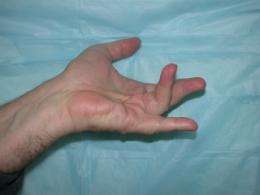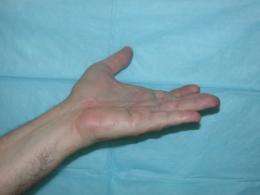Discovery of New Treatment for Hand Disorder Affecting Millions Shown Promising

(PhysOrg.com) -- Researchers in the Department of Orthopaedics at Stony Brook University Medical Center have developed an injectable form of the enzyme, collagenase, that significantly improves outcomes of Dupuytren’s contracture (or disease), a debilitating disorder caused by progressive accumulation of collagen that deforms fingers and limits motion.
Reported in September 3, 2009, issue of the New England Journal of Medicine, the study involved treatment of 308 patients with Duputren’s disease in 16 sites nationwide (content.nejm.org/cgi/content/short/361/10/968). The results indicate that the injections are safe and effective. Collagenase injections may offer another treatment option to hand surgery, the standard treatment.
Dupuytren’s disease is a progressive genetic fibroproliferative disorder in which normal collagen production and deposition in the hand fascia is disrupted and abnormal amounts of collagen production build nodules in the palm of the hand. Eventually collagen build-up produces cords in the hands of patients causing the fingers to be “bent” and unable to extend. This reduces finger dexterity to a high degree, to a point where common activities such as typing, cooking and even shaking hands become difficult and severely compromised. Millions worldwide are affected by Duputren’s contracture, with the highest incidence (3-to-6 percent) being in the Caucasian population of Northern European ancestry.
The condition is more common in men than women and increases in incidence with advancing age, diabetes, epilepsy, smoking, and excess use of alcohol.

Co-Principal Investigators Lawrence C. Hurst, M.D., Professor and Chair of the SBUMC Department of Orthopaedics, and Marie A. Badalamente, Ph.D., Professor of Orthopaedics, began working with collagenase more than 15 years ago in their laboratory when they first realized the enzyme had potential to treat Dupuytren’s disease. The investigative process has resulted in a bench-to-bedside story that began with successful laboratory results on breaking up collagen within fibroproliferative tissue of the cords. With Food and Drug Administration (FDA) permission, clinical research Phase 2 trials were conducted in over 200 patients using injections of collagenase as an experimental treatment for Dupuytren’s disease.
By 2007, Drs. Hurst and Badalamente began enrolling patients in a FDA-regulated multicenter Auxilium Pharmaceuticals, Inc. Phase 3 clinical trial that involved collagenase injections to treat the condition. Other participating institutions enrolling patients in the trial included Stanford Hospitals and Clinics in Palo Alto, Calif., University of California, Los Angeles, the Hospital for Special Surgery in New York, and the Indiana Hand Center in Indianapolis.
The collagenase injection therapy used in the trials is under review at the FDA for approval as a nonsurgical treatment of Dupuytren’s disease. The SBUMC-led Phase 3 clinical trial is the first comprehensive analysis of Dupuytren’s disease patients treated with collagenase injections.
“Our study revealed that injections of the collagenase into the cords causing the finger contractures weaken the cords significantly,” says Dr. Hurst. “The next day we found that we could manipulate the patients fingers and break the cords causing the contracture. The result is frequently a normally functioning hand.”
As reported in the NEJM article,“Injectable Collagenase Clostridium Histolyticum for Dupuytren’s Contracture,” 308 patients with joint contractures of 20 degrees or more received up to three injections of collagenase or placebo. A total of 203 patients received the collagenase. One day after injection, the joints were manipulated. The goal of the treatment was to achieve a reduction in contracture of zero to 5 degrees of full digit extension within 30 days after the final injection. Patients were evaluated 90 days post-treatment.
Upon evaluation, the investigators found that contractures were reduced to zero to 5 degrees of full extension (zero degrees) in nearly two-thirds (64 percent) of joint contractures with collagenase, as compared to 6.8 percent of those placebo-injected.
Among all the cords causing joint contracture that were injected with collagenase, 84.7 percent showed improvement, compared with placebo (11.8 percent). In addition, collagenase-injected joint contractures showed a much greater percent reduction in the contracture from baseline to 30 days after the final injection - 79.3 percent compared to 11.4 percent, respectively.
While injection-site pain, tenderness, and other common adverse affects were common for patients as a result of the procedure, most adverse events or side effects were mild-to-moderate and were resolved quickly and without intervention.
Dr. Hurst says that most patients with advanced Duputren’s disease would be candidates for treatment with injectable collagenase regardless of age. He also contends that because the majority of patients with the condition are older and often have other significant comorbidities (i.e. diabetes), they are more likely to experience neurovascular injury, hematoma, and infection following surgery. Recurrence after surgery also remains problematic.
“Surgery is often successful but it is not the most desired option for many patients,” he adds. “Recuperation is often long and sometimes requires substantial hand therapy.”
The national working group for the study is called the Collagenase Option for Reduction of Dupuytren’s (CORD I) Study Group. The study was financially supported by Auxilium Pharmaceuticals, Inc. The clinical trial was designed by the CORD I Study Group and Auxilium.
The Department of Orthopaedics, in collaboration with Stony Brook University, is planning to open the Dupuytren’s Institute at Stony Brook to further support patient care, research, and educational aspects of this debilitating disease which so often interferes with the quality of life, particularly in later years.
Provided by Stony Brook University (news : web)
















